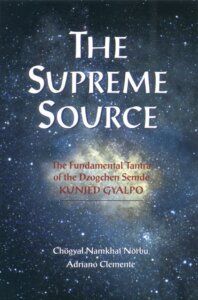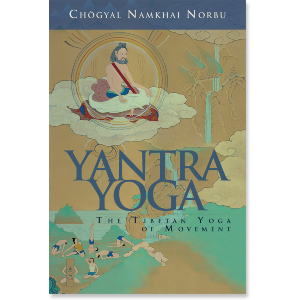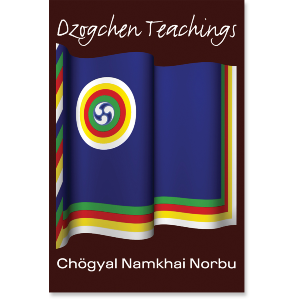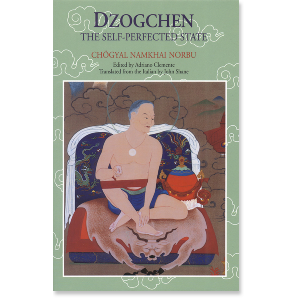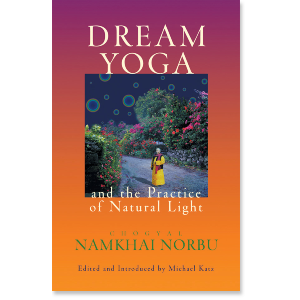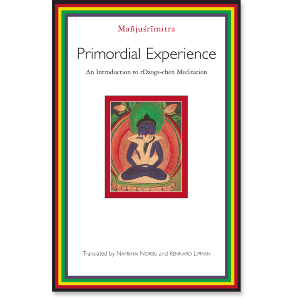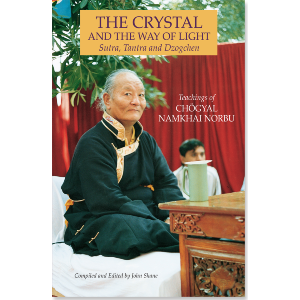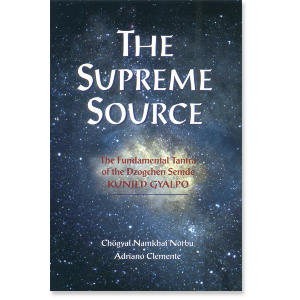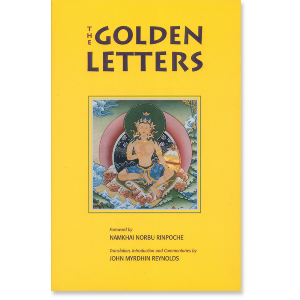| The following article is from the Autumn, 1999 issue of the Snow Lion Newsletter and is for historical reference only. You can see this in context of the original newsletter here. |
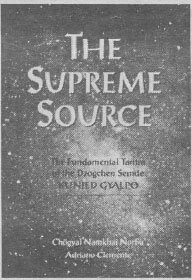
The Supreme Source: The Fundamental Tantra of Dzogchen Semde
By Chogyal Namkhai Norbu
By Adriano Clemente
The aim of Dzogchen is the reawakening of the individual to the primordial state of enlightenment which is naturally found in all beings. The master introduces the student to his or her real nature, already perfected and enlightened, but it is only by recognizing this nature and remaining in this state of recognition in all daily activities that the student becomes a real Dzogchen practitioner of the direct path of self-liberation. The Dzogchen practitioner is aware of the absolute clarity and purity of his or her own mind and, without trying to modify what is already perfect in itself, without striving to obtain from somewhere else the state of realization, remains always in the real nature of existence, in the supreme source of all phenomena. Those who try to meditate and to realize this condition through effort are like a blind man chasing the sky.
In this book, the Dzogchen teaching is presented through one of its most ancient texts, the tantra Kunjed Gyalpo or The King who Creates Everything a personification of the primordial state of enlightenment. This tantra is the fundamental scripture of the Semde or Nature of Mind tradition of Dzogchen and is the most authoritative source for understanding the Dzogchen view. The oral commentary by Chogyal Namkhai Norbu gives easier insight into the depths of these teachings from a practical point of view. Adriano Clemente translated the main selections of the original tantra. The Supreme Source will be of great interest to all students of Tibetan Buddhism.
The following is an excerpt from the book.
Dzogchen Atiyoga
With atiyoga we reach the culmination of the paths of realization: Dzogchen, or total perfection, whose characteristic path, being based on the knowledge of self-liberation, does not entail any more transformation. In fact, when we understand the principle of self-liberation, we come to recognize that not even the method of transformation of tantra is the ultimate path. The fundamental point of the practice of Dzogchen, called tregchod or release of tension, is to relax in the state of contemplation, while the way to remain in this state is called chogshag, leaving as it is.
Doing a visualization, a practice of transformation of impure vision into a maŒÁala etc., means constructing something, working with the mind, whereas in the state of contemplation, body, voice, and mind are totally relaxed, and it must indispensably be this way. A term used very frequently in Dzogchen is machopa, not corrected, or not altered, whereas transformation means correcting,
considering that there is impure vision on one side and pure vision on the other. Thus, all that is necessary to enter into the state of contemplation is to relax, and there is no need of any transformation practice. Some people believe that Dzogchen is only the final phase of tantric practice, rather like the Mahamudra of the modem tradition, but this is because the arrival point of the path of anuyoga, too, is called Dzogchen. In reality, Dzogchen atiyoga is a path complete in itself, and, as already mentioned above, is not dependent on the methods of the path of transformation.
When we follow the Dzogchen teaching, if we have sufficient capacity, we can start directly with the practice of contemplation. The only really indispensable thing is the practice of guru yoga or unification with the state of the teacher, because it is from the teacher that we receive the direct introduction to knowledge.
The original atiyoga tantras, such as the Kunjed Gyalpo, often assert that the characteristic feature of Dzogchen is the absence of the ten requisites of the practice of Tantra: initiation, mantra, mandala, visualization, and so on. Why are they absent in Dzogchen? Because they are ways of correcting or altering the true nature of the individual, but in reality there is nothing to change or to improve, all that is necessary is to discover the real condition and to remain relaxed in that state. So it is important to understand that the word Dzogchen refers to the state of the individual and that the purpose of the Dzogchen teaching is to enable one to understand this condition.

In no way is the Dzogchen teaching intended to build a new cage in place of the one in which we already I find ourselves; on the contrary, it serves as a key to open the door of the cage.

In general, the Dzogchen teaching is explained through three fundamental aspects: the base, the path, and the fruit. The base is the primordial state of the individual and is further explained through the principle of the three wisdoms, or three natural conditions: essence, nature, and energy. One of the clearest examples to help understand this point is that of the mirror. In fact, the relative and the absolute condition can both be represented symbolically by a mirror, the former by the images reflected in the mirror and the latter by the mirror's intrinsic potentiality to reflect. The same holds for the state of the individual. What is the individual? It is the one who possesses the primordial state of consciousness, comparable to the nature of the mirror that is pure, clear, and limpid. This corresponds to the three conditions called essence, nature, and energy. Just as a reflection arises from the mirror and in a certain sense is a quality of the mirror, all of our thoughts and all of the manifestations of our energy, both beautiful and ugly, are only our own reflection, a quality of our primordial state. If we are aware and are really in this state, everything becomes a quality of ours and there is no longer any separation into subject and object or any consideration of relative and absolute.
We have said that as individuals we are made up of our own primordial state as essence, nature, and energy. However, we should not think of these three aspects as if they were three separate objects: the original condition is one alone, and the fact that it is explained through three distinct concepts is only to help understand it. In reality we cannot define or distinguish this is purity, this is clarity, and this is limpidity.
What is the essence? In order to discover the primordial state the reflection is needed, that in this case comprises the body, voice, and mind, and particularly the last of these three. In fact, it is from the mind that thoughts arise. If a thought arises while we are observing the mind, we must seek whence the thought originates, where it abides and, finally, where it disappears. However, the moment we recognize the thought it disappears and we find nothing at ail: there is no origin, no abiding, and no place where it disappears. We find there is nothing, which is why the essence is said to be emptiness.
The concept of emptiness, or sunyata, is very widespread in Mahayana Buddhism, particularly in the Prajnaparamita tradition. However the fundamental point to understand is that emptiness is the true essence of material phenomena and not some abstract and separate entity. In fact, the same exercise of seeking the origin of thought can be applied to any object perceived by the senses. If we see a beautiful object and examine whence this beauty arises and where it disappears, we find nothing concrete: everything is at the same level; both subject and object are in essence empty. Just this is the ultimate condition of the individual.
What is clarity? If the essence is emptiness this does not mean that nothing exists. When we observe a thought and it disappears, immediately afterwards another thought arises, that might be: I am seeking the origin of thought and I find nothing! This too is a thought, is it not? It is a thought that thinks about the origin of thought. In this way many thoughts can arise continuously. Even though we may be convinced that their essence is emptiness, nevertheless they manifest ceaselessly. The same applies to our senses: all the objects we perceive are the ceaseless appearing of our karmic vision. This, then, is the nature of clarity.
What is energy, or the potentiality of energy? It is the active and uninterrupted function of the nature of our primordial state. In general, one talks of the function of wisdom in relation to the pure vision of an enlightened being and of the function of the mind in relation to the impure vision of samsara. For example, we think something and then we follow this thought and enter into action. Or, while we are practicing, we transform ourselves into a deity with that deity's mandala and pure dimension. All of this evinces the function of energy in the aspects of its continuity and its capacity to produce something. Through our energy there arise all the manifestations at the level of subject and object, that can be pure or impure, beautiful or ugly, etc. If we place a crystal in sunlight, we immediately see it radiate many iridescent rays. In this case, the crystal represents the state of the individual and the colors that manifest externally represent everything that we see and perceive through the senses. This mode of manifestation of energy, in which the reflection manifests externally, is called tsal in Tibetan. Impure vision tied to karma and to the material dimension and pure vision at the level of subject and object are both tsal manifestations of energy.
There is also a way in which energy manifests internally, in the subject itself, in the same way that images are reflected in a mirror: this is called rolpa. For example, when we do a tantric practice and transform ourselves into the dimension of a deity with its mandala, we are working with this kind of energy, because everything is taking place inside us. Obviously, in the first stages of the practice of transformation, it is very important to utilize the mind, concentration, etc., in order to achieve this function concretely. But at a certain point the pure dimension of the mandala can manifest even without any effort on our part, and this occurs through rolpa energy.
The third way energy manifests is called dang, and represents somewhat the basic condition of energy, its potentiality to take on any form according to circumstances. The traditional example is that of a crystal placed on a cloth: the crystal will take on the color of the cloth even though in itself it is transparent and colorless.
Essence, nature and, energy are called the three primordial wisdoms because they represent the state of enlightenment in its entirety. The individual has these three aspects from the very beginning and continues to have them even upon the accomplishment of total enlightenment. One might think: What then is the point of practicing, if we already have the same qualities as a Buddha? We can just stay in peace doing nothing! Of course we can stay in peace doing nothing as long as we are not distracted, as long as we really find ourselves in this state. But if it is otherwise, it means we are slaves to dualism, conditioned by the object. In this case it is not enough to think that we have the essence, nature, and energy: conditioning by dualistic vision is precisely the obstacle that we need to overcome in order to allow the sun of the primordial state to shine again.
This is the reason why the path is necessary, that in its turn encompasses the three aspects of view, meditation, and behavior. In Dzogchen the view, or perspective, does not address something external, it means simply observing oneself in order to discover one's true condition. Basically, it means discerning the dualistic conditioning undergone by the body, voice, and mind in order to overcome it through practice. In no way is the Dzogchen teaching intended to build a new cage in place of the one in which we already find ourselves; on the contrary, it serves as a key to open the door of the cage. In fact, it is not enough to discover we are trapped in the cage of dualism: we need to get out of it, and this is the purpose of meditation.
As regards the second aspect, meditation, even though at the start it is necessary to utilize methods of concentration, breathing, etc., to calm the mind and foster a condition of stability, the true purpose of meditation is continuity of awareness, or presence of the primordial state. Here we should speak rather of contemplation, the essential point of which is pure instant presence, or rigpa. The Dzogchen practitioner seeks to understand this state of presence through diverse experiences: of emptiness, of clarity, of sensations of pleasure, and so on. Actually, the aim of the methods in the sutras and the tantras is also solely to kindle experiences. The true path of the Dzogchen practitioner, however, is contemplation. In fact, it is only when we are in contemplation that all the tensions of body, voice, and mind are finally effortlessly released: until we discover and abide stably in this state, our experience of relaxation will be incomplete. Contemplation, as suggested above, can be tied to an experience of emptiness, of clarity, or of bliss, but its state is one alone: the instant presence of rigpa. There exist various methods to recognize, establish, and integrate this state in all the circumstances of everyday life tied to the three fundamental series of Dzogchen: Semde, Longde, and Mennagde.
Behavior, the last of the three aspects of the path, concerns the attitude practitioners should have the moment they come out of a session of contemplation and undertake various activities. Its purpose is thus to achieve the total integration of contemplation with everyday life, overcoming any differentiation between meditation and non-meditation.
Let us now turn to the third and final aspect of the Dzogchen teaching, the fruit or result of practice: realization. We have already said that the primordial state contains in potentiality the manifestation of enlightenment. The sun, for example, naturally has light and rays, but when the sky is cloudy, we do not see them. The clouds in this case represent our obstacles that are a result of dualism and conditioning: when they are overcome, the state of self-perfection shines with all its manifestations of energy, without ever having been altered or improved. This is the characteristic principle of Dzogchen. Not understanding this may lead one to think that Dzogchen is the same as Zen or Ch'an. At heart, Zen, which without any doubt is a high and direct Buddhist teaching, is based on the principle of emptiness as explained in sutras such as the Prajnaparamita. Even though in this regard, in substance it is no different from Dzogchen, the particularity of Dzogchen lies in the direct introduction to the primordial state not as pure emptiness but rather as endowed with all the aspects of the self-perfection of energy. It is through applying these that one attains realization.
Concerning the fruit, there are the three kayas, bodies or dimensions: dharmakaya, sambhogakaya, and nirmanakaya. In no manner are the three kayas levels of realization: there cannot be a dharmakaya without a nirmanakaya, or vice-versa. In order to understand their meaning we must return to the concepts of essence, nature, and energy. Kaya means body, and thus the whole dimension, both material and immaterial, in which we find ourselves; dharma means existence. So dharmakaya is the total dimension of existence, without any exclusion. Thus it corresponds to the essence, the ineffable and immeasurable condition beyond all the concepts and limits of dualism.
Sambhoga means wealth or enjoyments, so sambhogakaya means the dimension of wealth. In this case wealth does not refer to something material but rather to the self- perfected qualities that manifest through the substance of the elements, that is, through color. In fact, when the elements take on the material state, they pass from the level of color to the solid level of the physical elements. In brief, everything that we consider as the pure dimension of the mandala and of the deity pertains to the sambhogakaya, the source of the transmission of Tantra. This corresponds to the aspect of the nature of clarity of the primordial state.
The word nirmanakaya can also refer to a realized individual, such as Sakyamuni Buddha, who takes on a physical form in order to transmit the teachings. In fact, it is only in the nirmanakaya dimension that the teachings can be uttered and transmitted at the level of subject and object. The sambhogakaya is that dimension in which the potentialities of sound, light, and rays (sgra, od, zer), the three fundamental sources of manifestation, appear as the pure vision of the mandala, the origin of the tantric teachings. The books called tantras, that contain the revelations of these manifestations, constitute the testimony of teachers who had direct contact with the sambhogakaya and only later put it in writing. As regards the Dzogchen teaching in particular, its tantras are said to arise directly from dharmakaya, symbolized by the primordial Buddha Samantabhadra depicted as a sky- blue Buddha, naked and unadorned: the original purity of the state of the individual.


